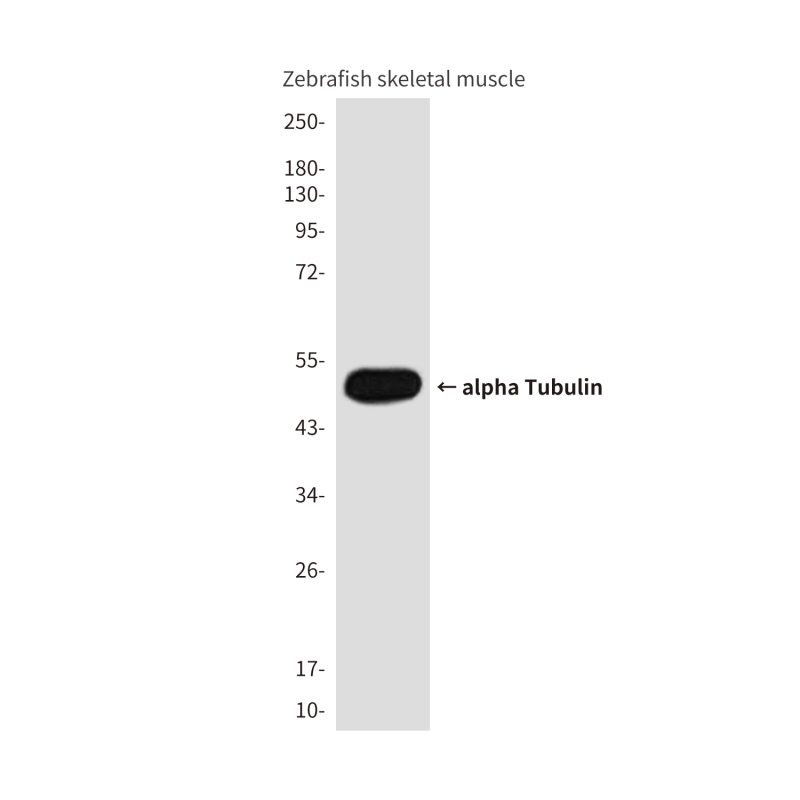

| WB | 咨询技术 | Zebrafish |
| IF | 咨询技术 | Zebrafish |
| IHC | 咨询技术 | Zebrafish |
| ICC | 技术咨询 | Zebrafish |
| FCM | 咨询技术 | Zebrafish |
| Elisa | 咨询技术 | Zebrafish |
| Aliases | Tubulin alpha-1B chain; Alpha-tubulin ubiquitous; Tubulin K-alpha-1; Tubulin alpha-ubiquitous chain |
| Entrez GeneID | 10376 |
| clone | 9B7 |
| WB Predicted band size | Calculated MW: 50 kDa; Observed MW: 50 kDa |
| Host/Isotype | Mouse IgG1 |
| Antibody Type | Primary antibody |
| Storage | Store at 4°C short term. Aliquot and store at -20°C long term. Avoid freeze/thaw cycles. |
| Species Reactivity | Zebrafish |
| Immunogen | Recombinant Protein of Tubulin alpha-1A chain |
| Formulation | Purified antibody in PBS with 0.05% sodium azide,0.5%BSA and 50% glycerol. |
+ +
以下是3篇关于斑马鱼特异性α-Tubulin抗体的参考文献概览:
1. **"Microtubule organization in the zebrafish yolk cell during epiboly"**
*Author: Solnica-Krezel L. et al.*
摘要:研究利用斑马鱼特异性α-Tubulin抗体,分析卵黄细胞在胚胎外包(epiboly)过程中微管动态,揭示微管网络对细胞形态变化的关键作用。
2. **"Axonogenesis in the zebrafish brain: α-Tubulin as a neuronal marker"**
*Author: Wilson S.W. et al.*
摘要:通过免疫荧光染色验证该抗体对斑马鱼脑部神经元轴突的特异性标记,为神经发育研究提供可靠工具。
3. **"Cilia assembly in zebrafish embryos: α-Tubulin antibody applications"**
*Author: Huang P. & Schier A.F.*
摘要:使用该抗体检测纤毛微管结构,证明其在斑马鱼早期胚胎纤毛形成研究中的高特异性和敏感性。
4. **"Validation of zebrafish-specific antibodies for developmental studies"**
*Author: Thisse C. & Thisse B.*
摘要:系统性评估包括α-Tubulin在内的斑马鱼抗体,通过Western blot和免疫组化确认其组织特异性及适用发育阶段。
这些文献覆盖了胚胎发育、神经生物学及方法学验证,均强调该抗体在斑马鱼模型中的可靠性和应用场景。
Alpha-tubulin, a core component of microtubules, plays critical roles in maintaining cell structure, facilitating intracellular transport, and regulating cell division. In zebrafish (*Danio rerio*), a widely used vertebrate model for developmental and genetic studies, alpha-tubulin is essential for processes like embryogenesis, neurogenesis, and organogenesis. The zebrafish-specific alpha-tubulin antibody is designed to recognize and bind to epitopes unique to zebrafish alpha-tubulin isoforms, minimizing cross-reactivity with homologs from other species. This specificity is crucial for accurate detection in experiments involving zebrafish tissues or cells, particularly given the high conservation of tubulin across eukaryotes.
Developed through immunogen sequences derived from zebrafish alpha-tubulin, the antibody is validated for applications such as immunofluorescence, immunohistochemistry, and Western blotting. It enables visualization of microtubule dynamics in vivo, aiding studies on cell polarity, axon guidance, and cilia formation during zebrafish development. Researchers frequently use it in whole-mount embryo staining to map microtubule networks in real-time, leveraging the transparency of zebrafish larvae.
Its utility extends to disease modeling, including ciliopathies or neurodevelopmental disorders, where microtubule dysfunction is implicated. Commercial variants often include monoclonal or polyclonal formats, with host species like mouse or rabbit. Proper controls, such as knockout validation, are recommended to confirm signal specificity. This antibody remains a vital tool for dissecting microtubule-related mechanisms in zebrafish, bridging cellular biology with organismal-level insights.
×